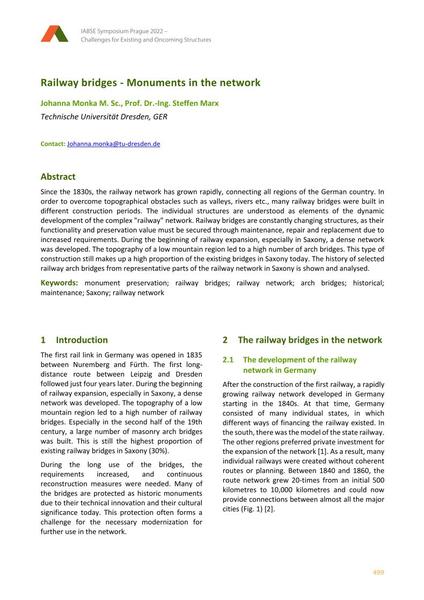Railway bridges - Monuments in the network

|
|
|||||||||||
Bibliografische Angaben
| Autor(en): |
Johanna Monka
(Technische Universität Dresden, GER)
Steffen Marx (Technische Universität Dresden, GER) |
||||
|---|---|---|---|---|---|
| Medium: | Tagungsbeitrag | ||||
| Sprache(n): | Englisch | ||||
| Tagung: | IABSE Symposium: Challenges for Existing and Oncoming Structures, Prague, Czech Republic, 25-27 May 2022 | ||||
| Veröffentlicht in: | IABSE Symposium Prague 2022 | ||||
|
|||||
| Seite(n): | 499-506 | ||||
| Anzahl der Seiten (im PDF): | 8 | ||||
| DOI: | 10.2749/prague.2022.0499 | ||||
| Abstrakt: |
Since the 1830s, the railway network has grown rapidly, connecting all regions of the German country. In order to overcome topographical obstacles such as valleys, rivers etc., many railway bridges were built in different construction periods. The individual structures are understood as elements of the dynamic development of the complex "railway" network. Railway bridges are constantly changing structures, as their functionality and preservation value must be secured through maintenance, repair and replacement due to increased requirements. During the beginning of railway expansion, especially in Saxony, a dense network was developed. The topography of a low mountain region led to a high number of arch bridges. This type of construction still makes up a high proportion of the existing bridges in Saxony today. The history of selected railway arch bridges from representative parts of the railway network in Saxony is shown and analysed. |
||||
| Stichwörter: |
Bogenbrücken historisch Wartung
|
||||
| Copyright: | © 2022 International Association for Bridge and Structural Engineering (IABSE) | ||||
| Lizenz: | Die Urheberrechte (Copyright) für dieses Werk sind rechtlich geschützt. Es darf nicht ohne die Zustimmung des Autors/der Autorin oder Rechteinhabers/-in weiter benutzt werden. |
||||

